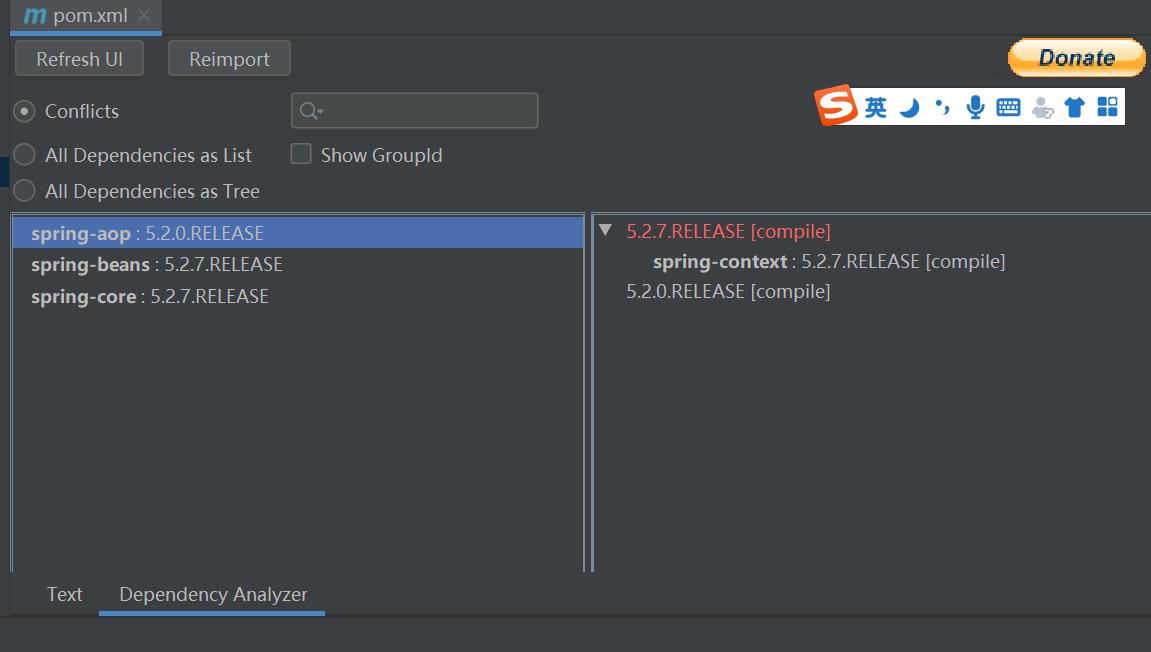slf4j依赖包冲突
Posted
tags:
篇首语:本文由小常识网(cha138.com)小编为大家整理,主要介绍了slf4j依赖包冲突相关的知识,希望对你有一定的参考价值。
参考技术A 首先要明确slf4j是什么。他是将各个底层的日志框架抽象出来的一个接口层。底层的实现还是依赖于之前的各个框架。只是将各个框架经过改变,原理照搬。适配成可以统一抽象的slf4j文件。那么这个包冲突就在于。一个接口由多个框架实现。slf4j不知道用哪个好了。冲突多发生在logback和log4j中。springboot默认用logback。这两个框架是一个人写的。因为觉得log4j不够好。才又写了logback。所以我们也用logback框架。接下来抛出问题和解决方案
SLF4J: Class path contains multiple SLF4J bindings.
SLF4J: Found binding in [jar:file:/D:/SoftWareInstall/CodeTool/Maven/Repository/ch/qos/logback/logback-classic/1.2.3/logback-classic-1.2.3.jar!/org/slf4j/impl/StaticLoggerBinder.class]
SLF4J: Found binding in [jar:file:/D:/SoftWareInstall/CodeTool/Maven/Repository/org/apache/logging/log4j/log4j-slf4j-impl/2.12.1/log4j-slf4j-impl-2.12.1.jar!/org/slf4j/impl/StaticLoggerBinder.class]
SLF4J: See http://www.slf4j.org/codes.html#multiple_bindings for an explanation.
SLF4J: Actual binding is of type [ch.qos.logback.classic.util.ContextSelectorStaticBinder]
很明显。是由于第二个的log4j冲突了。我们定位到这个具体的log4j是有pom.xml中哪个dependency引入的,然后在dependency内部添加如下剔除
<exclusions>
<exclusion>
<groupId>org.slf4j</groupId>
<artifactId>slf4j-log4j12</artifactId>
</exclusion>
<exclusion>
<groupId>log4j</groupId>
<artifactId>log4j</artifactId>
</exclusion>
<exclusion>
<artifactId>log4j-slf4j-impl</artifactId>
<groupId>org.apache.logging.log4j</groupId>
</exclusion>
</exclusions>
不知道怎么找的。可以在idea的pom.xml中
光标放在依赖id处
maven依赖冲突以及解决方法
什么是依赖冲突
依赖冲突是指项目依赖的某一个jar包,有多个不同的版本,因而造成类包版本冲突
依赖冲突的原因
依赖冲突很经常是类包之间的间接依赖引起的。每个显式声明的类包都会依赖于一些其它的隐式类包,这些隐式的类包会被maven间接引入进来,从而造成类包冲突
如何解决依赖冲突
首先查看产生依赖冲突的类jar,其次找出我们不想要的依赖类jar,手工将其排除在外就可以了。具体执行步骤如下
1、查看依赖冲突
a.通过dependency:tree是命令来检查版本冲突
mvn -Dverbose dependency:tree
当敲入上述命令时,控制台会出现形如下内容
[INFO] org.example:hello:jar:1.0-SNAPSHOT
[INFO] +- org.springframework:spring-context:jar:5.2.7.RELEASE:compile
[INFO] | +- (org.springframework:spring-aop:jar:5.2.7.RELEASE:compile - omitted for conflict with 5.2.0.RELEASE)
[INFO] | +- org.springframework:spring-beans:jar:5.2.7.RELEASE:compile
[INFO] | | \\- (org.springframework:spring-core:jar:5.2.7.RELEASE:compile - omitted for duplicate)
[INFO] | +- org.springframework:spring-core:jar:5.2.7.RELEASE:compile
[INFO] | | \\- org.springframework:spring-jcl:jar:5.2.7.RELEASE:compile
[INFO] | \\- org.springframework:spring-expression:jar:5.2.7.RELEASE:compile
[INFO] | \\- (org.springframework:spring-core:jar:5.2.7.RELEASE:compile - omitted for duplicate)
[INFO] \\- org.springframework:spring-aop:jar:5.2.0.RELEASE:compile
[INFO] +- (org.springframework:spring-beans:jar:5.2.0.RELEASE:compile - omitted for conflict with 5.2.7.RELEASE)
[INFO] \\- (org.springframework:spring-core:jar:5.2.0.RELEASE:compile - omitted for conflict with 5.2.7.RELEASE)
其中omitted for duplicate表示有jar包被重复依赖,最后写着omitted for conflict with xxx的,说明和别的jar包版本冲突了,而该行的jar包不会被引入。比如上面有一行最后写着omitted for conflict with 5.2.7.RELEASE,表示spring-core 5.2.0版本不会被项目引用,而spring-core 5.2.7版本会被项目引用
b.如果是idea,可以安装maven helper插件来检查依赖冲突
maven helper插件安装成功,点开pom.xml会发现多了一个Dependency Analyzer视图,如下

上面按钮的图标含义如下
- Conflicts(查看冲突)
- All Dependencies as List(列表形式查看所有依赖)
- All Dependencies as Tree(树形式查看所有依赖)
上图说明有3个jar存在冲突,点击冲突的jar,可以查看和哪个jar产生冲突,如下图

2、解决冲突
项目的pom.xml形如下
<dependencies>
<dependency>
<groupId>org.springframework</groupId>
<artifactId>spring-context</artifactId>
<version>5.2.7.RELEASE</version>
</dependency>
<dependency>
<groupId>org.springframework</groupId>
<artifactId>spring-aop</artifactId>
<version>5.2.0.RELEASE</version>
</dependency>
</dependencies>
通过查看依赖树,我们知道项目会引用5.2.7.RELEASE的spring core jar包,而不会引用5.2.0的jar包,如果我们想用5.2.0版本的spring core包,我们该如何做?
a、使用第一声明者优先原则
谁先定义的就用谁的传递依赖,即在pom.xml文件自上而下,先声明的jar坐标,就先引用该jar的传递依赖。因此我们如果要使用5.2.0版本的spring core包,我们可以改成如下声明
<dependencies>
<dependency>
<groupId>org.springframework</groupId>
<artifactId>spring-aop</artifactId>
<version>5.2.0.RELEASE</version>
</dependency>
<dependency>
<groupId>org.springframework</groupId>
<artifactId>spring-context</artifactId>
<version>5.2.7.RELEASE</version>
</dependency>
</dependencies>
查看依赖树
[INFO] org.example:hello:jar:1.0-SNAPSHOT
[INFO] +- org.springframework:spring-aop:jar:5.2.0.RELEASE:compile
[INFO] | +- org.springframework:spring-beans:jar:5.2.0.RELEASE:compile
[INFO] | | \\- (org.springframework:spring-core:jar:5.2.0.RELEASE:compile - omitted for duplicate)
[INFO] | \\- org.springframework:spring-core:jar:5.2.0.RELEASE:compile
[INFO] | \\- org.springframework:spring-jcl:jar:5.2.0.RELEASE:compile
[INFO] \\- org.springframework:spring-context:jar:5.2.7.RELEASE:compile
[INFO] +- (org.springframework:spring-aop:jar:5.2.7.RELEASE:compile - omitted for conflict with 5.2.0.RELEASE)
[INFO] +- (org.springframework:spring-beans:jar:5.2.7.RELEASE:compile - omitted for conflict with 5.2.0.RELEASE)
[INFO] +- (org.springframework:spring-core:jar:5.2.7.RELEASE:compile - omitted for conflict with 5.2.0.RELEASE)
[INFO] \\- org.springframework:spring-expression:jar:5.2.7.RELEASE:compile
[INFO] \\- (org.springframework:spring-core:jar:5.2.7.RELEASE:compile - omitted for conflict with 5.2.0.RELEASE)
b、使用路径近者优先原则
即直接依赖级别高于传递依赖。因此我们可以在最先的pom.xml添加如下内容
<dependencies>
<dependency>
<groupId>org.springframework</groupId>
<artifactId>spring-context</artifactId>
<version>5.2.7.RELEASE</version>
</dependency>
<dependency>
<groupId>org.springframework</groupId>
<artifactId>spring-aop</artifactId>
<version>5.2.0.RELEASE</version>
</dependency>
<dependency>
<groupId>org.springframework</groupId>
<artifactId>spring-core</artifactId>
<version>5.2.0.RELEASE</version>
</dependency>
</dependencies>

通过上图可以看到项目引入是 spring core 5.2.0的包
c、排除依赖
排除依赖如果是idea,可以使用maven helper插件进行排除。点开pom.xml,切换到Dependency Analyzer视图,选择All Dependencies as Tree,点击要排除的jar,右键会出现Execlude选项,如下

它产生的效果和如下配置是一样
<dependencies>
<dependency>
<groupId>org.springframework</groupId>
<artifactId>spring-context</artifactId>
<version>5.2.7.RELEASE</version>
<exclusions>
<exclusion>
<artifactId>spring-core</artifactId>
<groupId>org.springframework</groupId>
</exclusion>
</exclusions>
</dependency>
<dependency>
<groupId>org.springframework</groupId>
<artifactId>spring-aop</artifactId>
<version>5.2.0.RELEASE</version>
</dependency>
</dependencies>

通过上图可以看到项目引入是 spring core 5.2.0的包
4、版本锁定
使用dependencyManagement 进行版本锁定,dependencyManagement可以统一管理项目的版本号,确保应用的各个项目的依赖和版本一致。
如果我们项目中只想使用spring core 5.2.0的包,pom.xml可以改为如下
<dependencyManagement>
<dependencies>
<dependency>
<groupId>org.springframework</groupId>
<artifactId>spring-core</artifactId>
<version>5.2.0.RELEASE</version>
</dependency>
</dependencies>
</dependencyManagement>
<dependencies>
<dependency>
<groupId>org.springframework</groupId>
<artifactId>spring-context</artifactId>
<version>5.2.7.RELEASE</version>
</dependency>
<dependency>
<groupId>org.springframework</groupId>
<artifactId>spring-aop</artifactId>
<version>5.2.0.RELEASE</version>
</dependency>
</dependencies>

通过上图可以看到项目引入是 spring core 5.2.0的包
总结
综上就是maven如何排查依赖冲突以及解决方法,对于排查依赖个人比较推荐使用maven helper插件,至于解决依赖冲突个人推荐使用版本锁定的方法,此外dependencyManagement只是声明依赖,并不自动实现引入,因此子项目需要显示的声明需要用的依赖
以上是关于slf4j依赖包冲突的主要内容,如果未能解决你的问题,请参考以下文章
maven依赖包冲突如何处理 SLF4J: Class path contains multiple SLF4J bindings
maven依赖包冲突如何处理 SLF4J: Class path contains multiple SLF4J bindings
maven依赖包冲突如何处理 SLF4J: Class path contains multiple SLF4J bindings
maven依赖包冲突如何处理 SLF4J: Class path contains multiple SLF4J bindings
spring cloud启动zipkin,报错maven依赖jar包冲突 Class path contains multiple SLF4J bindings